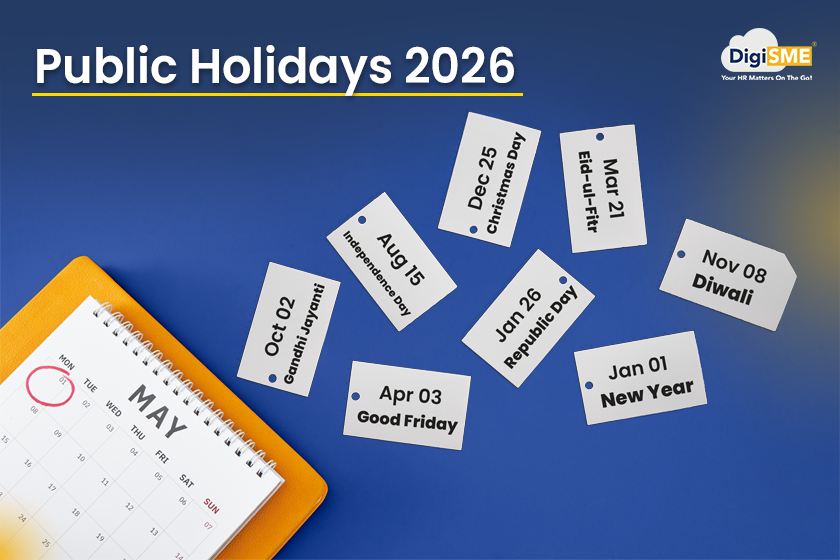Public holidays are more than calendar markers. For HR, payroll, operations, and customer teams, they drive staffing, shift design, service availability, cutoff dates, and employee engagement. This guide summarises the national picture for 2026, highlights dates that are fixed vs. festival dates that can change, and gives you a practical checklist so you can publish your internal holiday calendar, configure your HRMS, and stay compliant.
The Short Answer
- Fixed national days you can safely lock now: Republic Day (Jan 26, Monday), Independence Day (Aug 15, Saturday), Gandhi Jayanti (Oct 2, Friday).
- Popular festivals like Holi (Mar 3–4, 2026), Good Friday (Apr 3, 2026), Eid-ul-Fitr (likely Mar 21, 2026) and Diwali/Deepavali (Nov 8, 2026) are widely observed but some of them are moon-dependent and may shift by a day depending on official notices. Plan with “tentative” labels until state notifications are issued.
India 2026: Widely Observed Holidays And Likely Dates
Use this list as a planning scaffold, then layer your state notifications and company-specific restricted holidays. Dates for moon- or tithi-based festivals are marked “tentative”.
| Holiday | 2026 Date | Notes |
| New Year’s Day (varies by state) | Thu, Jan 1 | Observed in several states; not a pan-India gazetted holiday. |
| Republic Day | Mon, Jan 26 | National holiday (fixed). |
| Holi (Holika Dahan / Rangwali) | Tue–Wed, Mar 3–4 | Widely observed; date set by lunar calendar. |
| Good Friday | Fri, Apr 3 | Christian observance; public holiday in many states. |
| Labour Day / May Day | Fri, May 1 | Observed in many states. |
| Independence Day | Sat, Aug 15 | National holiday (fixed). |
| Gandhi Jayanti | Fri, Oct 2 | National holiday (fixed). |
| Diwali / Deepavali (tentative) | Sun, Nov 8 | Widely observed; final date per state circulars. |
| Christmas Day | Fri, Dec 25 | Observed nationally. |
Why “tentative”? Islamic and several Hindu festivals are confirmed by local authorities close to the event (moon sighting/tithi). Current astronomical guidance points to Eid-ul-Fitr around Sat, Mar 21, 2026, but expect official confirmation one day prior.
If you need a state-wise calendar (Tamil Nadu, Maharashtra, Karnataka, Gujarat, etc.), compile it after each state’s General Administration Department (GAD) circular is released, then publish an internal master with location filters in your HRMS.
How HR & Payroll Teams Should Use This Calendar
1) Publish Early, Label Wisely
Release a company holiday list with:
- “Gazetted/compulsory” holidays that apply to all locations.
- “Restricted/optional” holidays employees can pick from a curated list.
- A “tentative” tag for moon-dependent festivals (Eid, Muharram) and tithi-based dates until the state circular arrives. Source notes help. Use reputable references while you wait for state notifications.
2) Configure Your Systems
- Load 2026 holidays into your HRMS/attendance tool so public holidays don’t auto-flag as absence.
- Align payroll cut-offs to avoid bank holidays; run off-cycle payments where necessary.
- For multi-state teams, enable location-level calendars to prevent approval conflicts.
3) Plan Capacity For Long Weekends & Festival Peaks
- Holi, Diwali, and Eid weeks see higher leave demand. Use blackout periods only where business-critical, and offer compensatory offs or flexible staffing.
- Customer-facing teams: publish service-hour changes in advance.
4) Stay Region-Aware
Time-off expectations differ by state and by client base. For example, New Year’s Day is a state holiday in several regions; Pongal/Makar Sankranti clusters are big in the South and West; Muharram/Id-ul-Zuha depend on local moon sighting. Cross-check regional lists against national overviews.
5) Treat Holidays As Engagement Moments
A simple, inclusive calendar—festival greetings, short learning notes, optional cultural sessions—goes a long way. Recognition of regional observances boosts belonging and reduces friction when you need coverage on peak days.
Implementation Checklist For 2026
- Update the HRMS holiday master for each location and cost centre.
- Map payroll processing dates, salary credit days, and bank holidays.
- Align shift rosters and field-force routing for festival weeks.
- Publish a leave-planning guide for employees (how to apply, blackout windows, priority rules).
- Set your “restricted holidays” catalogue and quotas.
- Create a one-pager with contacts for urgent approvals during holiday closures.
- Reconfirm moon-dependent dates one day prior to observance based on official communiqués.
Final Thoughts
Public holidays aren’t just days off—they play a key role for HR, Payroll, operations, and company culture. Getting a jump on your 2026 holiday planning helps your organization run more, boosts employee happiness, and cuts down on unexpected issues.
Keep your systems prepared, your team in the loop, and your processes in sync—and 2026 could turn out to be your best year yet for holiday planning.
Frequently Asked Questions
- Do All Indian States Follow The Same Holiday List?
No. Three national holidays are common across India (Republic Day, Independence Day, Gandhi Jayanti). Most other holidays are notified by each state/UT. Always merge the national list with your state’s GAD circular.
- Why Do Some Festival Dates Move?
Islamic festivals follow local moon sighting; many Hindu festivals follow the lunar tithi. Authorities confirm final dates close to the event, so treat current dates as indicative until notified.
- Is Diwali On November 8, 2026?
Multiple reputable calendars currently indicate Sunday, November 8, 2026, for Diwali/Deepavali. Use this for planning, but defer final sign-off to your state’s holiday notification.
- When Is Holi In 2026?
Holi falls mid-week: Holika Dahan on Tuesday evening, March 3, and Rangwali Holi on Wednesday, March 4, 2026. Some states may notify one or both days.
- What’s The Best Way To Avoid Payroll Disruption?
Bring forward approvals and timesheet cut-offs in holiday weeks; configure holiday calendars in your HRMS; and plan off-cycle runs where bank closures collide with credit days. Cross-check against national overviews to avoid last-minute rework.

